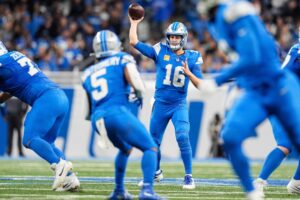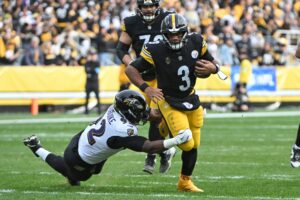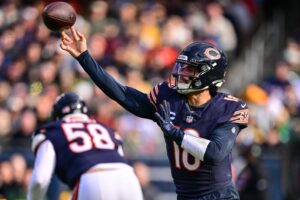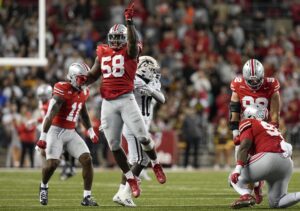The Baltimore Ravens lost their worst game of the 2020 season this past Sunday against the New England Patriots 23-17 in a monsoon at Gillette Stadium. The loss marked quarterback Lamar Jackson‘s first loss to a team under .500 since Week 3 of the 2019 season when Baltimore lost 40-25 to the Cleveland Browns. However, the loss to the Patriots on Sunday Night primetime is cause for concern. Not just because Baltimore lost to a significantly worse team than they are but because the Ravens suffered another round of key injuries. At the forefront is Ravens starting tight end Nick Boyle. Boyle is one of the best blocking tight ends in the NFL and is one of the key pieces to an offense that utilizes its tight ends perhaps more than any other in the league. He will now miss the remainder of the season with a left knee injury. Mark Andrews is currently the only tight end on the Ravens 53-man roster. This makes the Ravens miss Hayden Hurst.
Baltimore Ravens Feeling Repercussions of Hayden Hurst Trade
Having one active tight end is a large change from the three tight ends the Ravens carried on their roster in 2019. Perhaps now more than ever, the Ravens are going to feel the effects of trading Hurst. He was traded to the Atlanta Falcons during this past off-season and has since become one of the best receiving tight ends in the NFL. Currently, Hayden Hurst is third in receiving yards, tied for fourth in receptions, and tied for ninth in receiving touchdowns amongst tight ends. Hurst was used as both a blocker and a receiver for the Ravens but was unhappy with his role in Baltimore before requesting a trade.
Trading Hurst may have been inevitable but there is no doubt the Ravens are missing his presence in 2020. The three-headed monster at tight end was one of the biggest reasons for the Ravens offensive success in 2019 and now in 2020, only Andrews remains. Baltimore is feeling the repercussions of the Hurst deal and is now in an even tighter spot with Boyle being sidelined for the rest of the year.
The Terms of the Trade:
Baltimore receives – 2nd-round pick (running back J.K. Dobbins), 5th-round pick (traded to Jacksonville Jaguars for defensive tackle Calais Campbell*)
Atlanta receives – tight end Hayden Hurst, 4th-round pick (safety Jaylinn Hawkins)
*The trade for Campbell was agreed to prior to the trade for Hurst
Baltimore’s Offense Could Badly Use Hayden Hurst
The Ravens passing offense has been one of the largest topics of discussion for the team all season long. Jackson and his pass-catchers finished the 2019 season as the 27th ranked passing offense but the Ravens quarterback led the league in touchdown passes. He turned the ball over a minuscule eight times all year. In 2020, the Ravens passing attack is currently ranked 31st, averaging 184.1 passing yards per game only in front of Jackson’s predecessor Joe Flacco and the New York Jets. Jackson has thrown for just 14 touchdowns and has tied his turnover total (eight) from last season.
Baltimore retained a lot of their offense from 2019 outside of two players: perennial All-Pro guard Marshal Yanda and Hayden Hurst. Losing a player of Yanda’s caliber has understandably set the Ravens offensive line back but the loss of Hurst seems to be similarly significant.
Last season, Jackson completed a total of 125 passes to his tight ends — 43 percent of his completed passes. In 2020, his tight ends have caught a total of 47 passes for only 29 percent of his completion share. Tight ends have also received 50 percent of Jackson’s passing touchdowns. Andrews has caught the most passes on the Ravens in 2020 after trailing Marquise Brown in receptions last season.
Jackson showed a lot of love to his tight ends last season and he has not been able to rely on the group as much in 2020. Baltimore’s offense has already matched its 2019 total in drops through nine games in 2020. Having another pair of safe hands over the middle would greatly benefit the Ravens. Jackson clearly had a large level of comfort with each of his tight ends in 2019 and not having Hurst looks to have taken a toll on the entire offense.
How Is The Ravens Compensation Fairing?
Running back J.K. Dobbins was the main acquisition of the Hurst trade. He left Ohio State with the second-most career rushing yards (4,459) in school history after leading the Big 10 in rushing yards in 2019. His 2,003 rushing yards and 21 rushing touchdowns that season were each good for third in the entire NCAA.
Since becoming a Raven, Dobbins has had some growing pains. The Ravens rushing offense set the all-time record for yards in a single season last year but has taken a noticeable step back in 2020. While Baltimore’s offense currently ranks second in the NFL in rushing yards, it has largely been due to Jackson’s ability to use his legs. Last season’s MVP is currently averaging 5.8 yards per attempt and has totaled 524 yards through nine games. The Ravens as a team are averaging 5.02 yards per rushing attempt — down from 5.53 in 2019.
Despite a drop in overall production, Dobbins has been debatably the Ravens best running back. He is currently averaging the most yards per attempt on the team and is the only running back with over five catches (15). His 113 rushing yards against the Pittsburgh Steelers were also a high by any Raven this season. Dobbins’ only problem has been his consistency. Three of Dobbins’ four most productive games came in games in which he has had five or fewer touches. In five of the six games that Dobbins had six or more touches, he has totaled over 35 scrimmage yards just once.
Dobbins is still just a rookie so consistency will come as he matures. His next step will be performing better when called upon. A heavier workload for Dobbins has not translated to more success yet in 2020.
Can Baltimore Fortify Their Tight End Spot in 2020?
With just one tight end on the roster following the injury to Boyle, Ravens general manager Eric DeCosta elected to bring in veteran Luke Willson. Since being selected in the fifth round of the 2013 NFL Draft, Willson has spent part of eight seasons in the NFL. The 30-year-old played his first five seasons with the Seattle Seahawks before spending one season as a Detroit Lion. He then returned to the Seahawks for each of the 2019 and 2020 seasons before being cut in early November of this year.
Willson will now try and fill the void that Boyle has left in the blocking department. He has had to do a lot of run blocking in Seattle over the past few seasons and should be relied upon in a similar fashion in Baltimore. Replacing Boyle – debatably the best blocking tight end in the NFL – will be tough but the Ravens have very few options. Hurst did a decent amount of blocking as well as receiving last season and Willson should be involved in a similar way. Willson has 1,295 career receiving yards but has just 448 over the past five seasons.
Andrews’ 65 percent of offensive snaps played are easily a career-high through nine games this season, leaving the door open for Willson to get a lot of work. Like Andrews, Boyle had played 65 percent of offensive snaps through nine games in 2020. Offensive coordinator Greg Roman has no choice but to hope Willson can just be an adequate enough run blocker to not hinder the Ravens run game.
The Deal At A Glance
While there was likely no way to avoid an eventual move from Hurst, his presence is certainly missed. Baltimore’s trio of tight ends was such a large part of what made the Ravens offense so successful in 2019 and they have yet to find a viable replacement for that group of players. Hurst’s desire for a larger share of targets could only have kept him in Baltimore for so long and if not last off-season, he may have been on his way out this coming off-season. The deal was made as a long-term move and though it hasn’t paid off yet, could still turn into a win within the next few seasons. However, down to just one tight end from the big-three in 2019, the Ravens have a lot of work to do in replacing their production in 2020.
Main photo:
Embed from Getty Images






